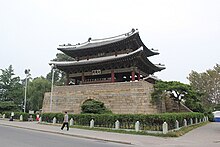| Taedongmun | |
 Taedongmun on the Taedong River in Pyongyang Taedongmun on the Taedong River in Pyongyang | |
| Korean name | |
|---|---|
| Chosŏn'gŭl | 대동문 |
| Hancha | 大同門 |
| Revised Romanization | Daedongmun |
| McCune–Reischauer | Taedongmun |
Taedongmun (Korean: 대동문; lit. Taedong Gate) is the eastern gate of the inner castle of the walled city of Pyongyang (Pyongyang Castle), and one of the National Treasures of North Korea. Located on the banks of the Taedong River, from which it gets its name, the gate was originally built in the sixth century as an official Koguryo construction, and, along with the Ryongwang Pavilion and Pyongyang Bell, served as the center of the inner castle's eastern defenses. The present construction dates from 1635, however, as the original was burnt to the ground during the Imjin wars of the late 16th century.
The current gate features a granite base topped by a two-story pavilion, called the Euphoru Pavilion (읍호루, 挹灝樓), because of its grand views of the Taedong River. This pavilion houses two hanging name plaques, one, on the first storey, reading "Taedong Gate" and calligraphed Yang Sa-on, and the other, reading "Upho Pavilion", on the second storey and written by Pak Wi [ko] (박위).
It is National Treasure #4 in North Korea.
See also
References
- "Democratic People's Republic of Korea_Ancient History". www.korea-dpr.com. Archived from the original on 2014-07-10. Retrieved 2015-10-31.
External links
39°01′21″N 125°45′24″E / 39.02250°N 125.75667°E / 39.02250; 125.75667
Categories: